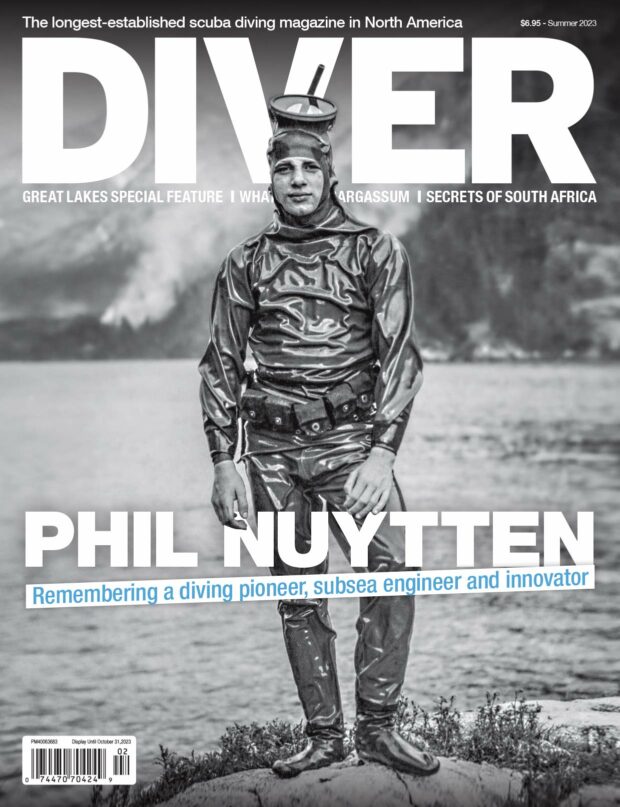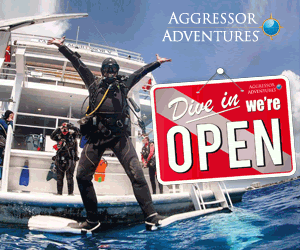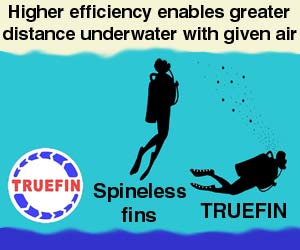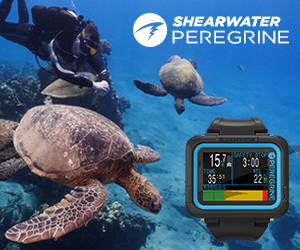Marketing Rebreathers
Jarrod Jablonski talks with Michael Menduno

Credit Where Credit Is Due
In my interview with explorer Jarrod Jablonski in DIVER Vol. 37 Number 1, I incorrectly stated that Jablonski and his team from Global Underwater Explorers were the first to video the USS Atlanta in 430 feet (130m) off Guadalcanal in the Solomon Islands. In fact, tech diving pioneers Terry Tysall (USA), Kevin Denlay (AUS) and their team videoed the USS Atlanta during their 1997 and 1998 expeditions after making their first exploratory dives on the wreck in 1995. Sorry guys!
———————-
In the current issue of DIVER Magazine (Volume 37 Number 1), I spoke with Jarrod Jablonski, the 42-year old explorer, educator and entrepreneur about his aquatic conservation membership organization, Global Underwater Explorers. GUE’sunique diver training program and operational standards have given rise to an enviable safety record and an impressive list of underwater discoveries by group members. Jablonski is the Chief Executive Officer of GUE and for gear manufacturer Halcyon Dive Systems and scuba retailer, Extreme Exposure Inc. He holds numerous records for the longest cave penetration, and the longest dives.
In this exclusive follow-up interview for divermag.com, I spoke more with Jablonski about the marketing of rebreathers to the technical and recreational diving communities.
I find it interesting that the GUE leadership and explorers are using the Halcyon RB80 semi-closed rebreather for exploration, but unlike most agencies, it seems like you are not actively promoting or marketing the rebreather or your training. In fact, looking at the GUE website or talking to people in the local organization here in Northern California you have to do some digging to realize that GUE even offers rebreather training, though you only offer it to individuals who are already very accomplished open-circuit technical divers.
I would say the pursuit of profit represents the primary motivator driving the promotion of rebreathers. Rebreather manufacturers and training agencies are looking to boost their revenues. This is somewhat understandable but I don’t feel like that’s our job at GUE. Our job is to safeguard the quality of education and the safety of the divers who entrust their lives to us as an organization. That’s really our only responsibility. That doesn’t mean I think rebreathers can’t be used safely. It just means that we take a really cautious approach to things that create greater risk; such risks must be balanced by meaningful benefit. Unfortunately the benefit is often lacking while using rebreathers for recreational purposes.
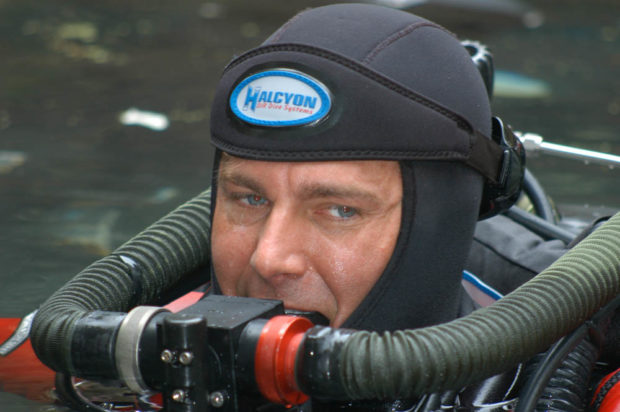
We talked about the concept of adding risk with little orno benefit—what you called “pointless risk”in the DIVERMagazine interview with regard to GUE’s ‘Doing It Right’ (DIR) standards. You said that’s the reason GUE doesn’t advocate the use of nitrox or air beyond 100 feet (30m), for example.
The logic is the same. If I’m average Joe Scuba Diver and most of my diving is in 50 feet (15m) of water and I go diving 10 times a year, what the hell do I need a rebreather for? I don’t and it’s just a huge expenditure that may significantly increase my risk. This is particularly true for someone who is barely active enough to remain proficient on general scuba gear. In my opinion, rebreathers are much more dangerous for that class of diver.
In fact, I believe that by and large the overwhelming numbers of people don’t really have any use for rebreathers. This is even true for many of my own dives. I own four rebreathers, but when I go down to Ginnie Springs to do an hour dive I rarely take my rebreather. Why? I don’t need it. It’s of no value to me on that dive. So that creates a really interesting psychological question. What is the efficacy of using something that doesn’t really add value but does add additional risk?
At the OZTek conference in May, Dr. Andrew Fock, head of hyperbaric medicine at the Alfred Hospital in Melbourne, Australia, said that his best estimate, from all existing data, is that rebreathers are 10 times as risky as open circuit scuba in terms of fatalities. In other words you are 10 times more likely to die on a rebreather than on open circuit scuba.
Yeah, and so think about that and how you would feel if your best friend or your wife was killed in 33 feet (10m) of water using a rebreather. You’d have to ask yourself, “why?” What happened? Does this make sense?
Why does a guy with tremendous experience like Wes Skiles (a veteran cave diver, filmmaker and photographer who died during a National Geographic film project in 2010 while diving a rebreather) die in 60 feet(18m) of water? Okay, fair enough it may not have been a rebreather failure, per se. But the fact a very experienced individual gets killed during a trivial dive in a way that would not happen while using open circuit, forces us to ask ourselves, does this make any sense? And unfortunately, Wes isn’t the only one.
PADI is now marketing rebreathers to recreational divers. As you know, they hosted a meeting at the annual Diving Equipment & Marketing Association (DEMA) show last year for all the rebreather manufacturers to spec out their requirements for a ‘recreational’ rebreather, the so-called Type R machines, as opposed to units suitable for tech divers, (Type T machines). They are in the process of rolling out their training program for recreational divers. To qualify, divers must have logged 25 dives with 10 of them on nitrox. They also launched rebreather courses for tech divers.
The situation seems very different than when PADI entered the tech diving market because back then, in 2000, there was a burgeoning market. Currently, there isn’t a market for recreational rebreathers; PADI is hoping to create one.
My guess is that PADI is watching its revenues decline, with fewer certifications and continuing drop out rate, and they’re trying to figure out how to pay for their infrastructure. So they are asking the question, what’s the best growth segment and everybody is telling them its rebreathers.
But there’s really not a recreational market? All right, let’s create one. We’ve got enough strength to do it.
So with PADI’s marketing muscle, manufacturers are going to create Type R-machines—there is already at least one on the market—and PADI centers and instructors will be there to train recreational divers in their use. Other agencies like the International Association of Nitrox & Technical Divers (IANTD) also offer recreational rebreather courses.
But basically PADI is creating this market, developing thousands of students who will be learning on a unit that has very little operational time. That’s problematic in my opinion. I appreciate the fiscal urgencies more than most but that doesn’t justify this sort of risk. What’s more is that they are targeting the bottom of the market. I mean these are the divers that we see putting their regulator on backwards. That’s the market they’re going after. That’s who they think is the customer. I strongly disagree with this strategy and I think it’s going to have negative consequences for the industry.
Because they risk leading the innocent to bad outcomes?
I have always been a champion of people’s individual rights, even when I think what they are doing is damn fool stupid. But, I strongly believe you have a responsibility to limit the exposure of people who don’t know better. And that applies to organizations as well as individuals. It’s one thing to do something yourself, but it’s another to promote it, because now you’ve taken on a different mantle of responsibility and I take that as a much stronger responsibility.
So you advocate caution?
Yes. I think we, as an industry, have to take a hard look at ourselves and say, “Really? That’s what this has come to? We’re going to push this technology on a group of people who are wholly unprepared to manage a rebreather, and we’re going to promote it because we can make money doing it.” You know, that really bothers me and I think it’s unethical.
Now I’m hardly against the free market. I run a for-profit manufacturing business and a retail dive store. I believe in making a profit. And I have every reason to promote rebreathers. My company sells a rebreather. But in this case, I see interesting parallels between our recent financial crisis that resulted from pushing mortgage-backed securities and the peddling of recreational rebreathers. Selling something people can’t afford (from a financial or personal risk point of view) or don’t really understand results in nice short term benefit but creates long term unsustainable risks that contaminate the entire industry.
People could end up dying instead of just losing their 401Ks.
Sadly, yes. The issue is one of appropriateness. There’s a low end of the market and the high end, which we clearly embrace. But I take a strong stance against supplying the casual diver with rebreathers.
I am not motivated to discourage capable and experienced divers from making their own decisions. These people have reached a level of experience, knowledge and capacity where they do, or should, know the risks they’re subjecting themselves to.
So where do you draw the line?
The hardest part for us as an organization is to figure out where that middle is, and that’s really what we’re doing. And we’re moving slowly because of rule number one. GUE’s job is to support the safety of the individual, notboost industry economics. Another reason that it has taken us some time, frankly, is that the rebreather industry is still relatively new. It’s taken more than a decade for rebreathers to start shaping up and I would say the top few rebreather companies are now legitimate, solvent, capable organizations. But even these companies are small and don’t sell more than a few hundred units a year.
So it’s not important to us that everyone is racing into rebreathers. What’s important is to carefully and slowly and methodically evaluate where that middle should be. I like to start at the top and work my way down because I think it’s safer to start with explorers and work our way from there.
So what specifically are your doing as an organization?
I have brought up the issue of rebreathers at our bi-annual training council meeting in each of the last three or four years. I have taken the pulse of the council, asked everybody what they’re seeing, what they’re hearing, what they feel, what requests they’re getting and we have discussed the issue. I also authorized the training council to start diving closed circuit rebreathers (CCRs). In fact, I have encouraged it. I said, look we’re trying to make decisions about the organization and what we need to do. So our job is to develop an internal experience base and use it to determine how far down the line we want to go. So we’ve all been doing that.
When you say CCR, you mean closed circuit rebreathers instead of the semi-closed rebreather that GUE explorers have been using?
Correct. All of our top people have already been using the Halcyon semi-closed system. But realistically semi-closed as it exists now isn’t really an appropriate tool for recreational diving because of the inherent oxygen drop in the system. Only a very experienced technical person should use it in shallower water. I wouldn’t put anyone who’s really recreationally inclined in 30 feet (9m) on a semi-closed rebreather. It just doesn’t make sense.
Briefly explain what you mean by oxygen drop?
Yes. A semi-closed system vents gas from the breathing loop. So for example with our unit, we have a ten-to-one ratio, so roughly 10 percent of that gas in blown off every breathing cycle and fresh gas is added. So the diver rebreathes some of the gas in the loop, and as a result, there is an oxygen drop from what’s in your gas supply to what the diver actually breathes from the loop and the amount of that drop is greater, the shallower you are. This decline occurs over time and relates to breathing rate, gas vented from the loop and depth, but as a rough example you might see a 10 point or greater oxygen drop in shallow water. So if you’re using 30 percent oxygen, it’s 20 percent oxygen at my mouth. But by the time I get to 300 feet (91m) it’s only a couple of percentage points. For deep diving it’s more or less irrelevant, but for shallow diving it’s pretty important.
Closed circuit units, which add oxygen directly to the loop, are more dangerous in some ways because they are more complicated, but they’re generally less dangerous in shallow water because they don’t have that particular oxygen problem. So CCRs are a more viable contender for shallow water diving.

So, as individuals you’re exploring closed circuit diving to inform your decisions as an organization?
That’s right. They’re taking classes, making dives, diving with others and gaining experience on different units. So our goal as an organization is to figure out, ultimately, if we want to condone rebreathers, how far down the chain are we going to condone them?
Currently we allow only those divers who have completed our Tech 2 course, which is a pretty high level of proficiency, to dive the Halcyon rebreather. We’re considering lowering that but we’re doing it through careful and progressive experience and trials and trying to decide if we want to move in this direction, and if so, then exactly how we might do it.
So for us, I think that you will see GUE very slowly migrate from providing rebreathers to individuals with a ‘very high’ level of expertise, to individuals with a ‘pretty high’ level of expertise. But it’s unlikely you’ll ever see us go any lower.

